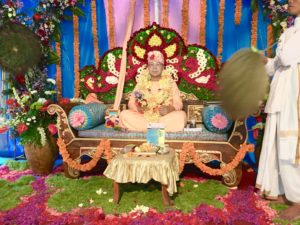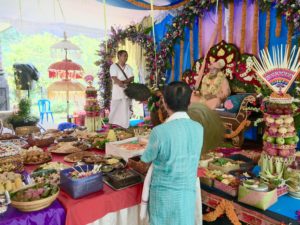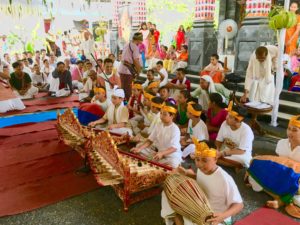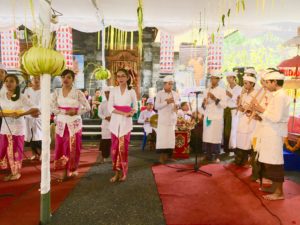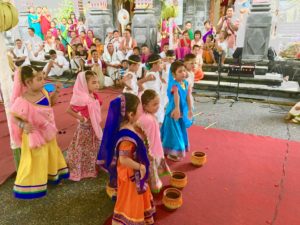
Jahnavi Harrison & Friends at Wellbeing Festival 2016
RISE by Radhanath Swami, A New App to Take Spirituality to Every Phone and Tablet
→ ISKCON News

Rise brings its users short bursts of wake-up wisdom from the comfort of their phones. It has simple, uncomplicated spiritual tools specific for everyone’s needs. If you’re stressed, search through the videos on stress. If you’re looking for advice on relationships, search through the videos on relationships. And if you’re looking to realize your inner self, the app may even have something for that too. It’s a practical, accessible approach to spirituality created for the modern world, which is why it all fits into everyone’s mobile.
Narottam says “Although I am dwarf, still I want to touch the moon.”
→ SivaramaSwami.com
The First Touch of Winter in New Vraja Dhama
→ SivaramaSwami.com
Kunjabihari dd’s video. https://youtu.be/u-6c6eSZyPc
Ramayana Reflection Series
→ The Spiritual Scientist
Ramayana Reflection – Why Rama abandoned Sita
Ramayana Reflection – Hanuman in Lanka 1 – Overcoming Obstacles
Ramayana Reflection – Hanuman in Lanka 2 – Discouraged yet determined
Ramayana Reflection – Hanuman in Lanka 3 – Exceeding Expectations
The post Ramayana Reflection Series appeared first on The Spiritual Scientist.
Ramayana Reflection – Hanuman in Lanka 3 – Exceeding Expectations
→ The Spiritual Scientist
Answer Podcast
Download by “right-click and save content”
The post Ramayana Reflection – Hanuman in Lanka 3 – Exceeding Expectations appeared first on The Spiritual Scientist.
Double Kirtan bliss at Qi
→ sriprahlada.com
ISKCON 50 Meditations: December 9, 2016
→ ISKCON News
Our decision, our destination (Subhashita commentary)
→ The Spiritual Scientist
vrajaty adhaḥ prayāty uccair naraḥ svair eva ceṣṭitaiḥ
adhaḥ kūpasya khanaka ūrdhvaṁ prāsāda-kārakaḥ
vrajati — slides; adhaḥ — down; prayāti — rises; uccaiḥ — higher; naraḥ — a man; svaiḥ — by his own; eva — certainly; ceṣṭitaiḥ — deeds; adhaḥ — goes down; kūpasya — of the well; khanakaḥ — digger; ūrdhvaṁ — goes up; prāsāda-kārakaḥ — the constructor of a home;
Translation: One sinks or rises in life by one’s own deeds, just as the person who digs a ditch goes down, whereas the person who constructs a house rise up.
— (Subhāṣita-ratna-bhāṇḍāgāra, Sāmānya-nītiḥ, Verse 62)
We live in an uncertain world where many things can go wrong at any moment. To stay steady amidst such uncertainty, we need something certain to hold on to. One certain truth is that ultimately our decisions determine our destinations; we end up where we choose to go.
True, the reactions to our actions may not come immediately; the philosophy of karma explains that many nuances shape the correlation between action and reaction. The Bhagavad-gita (04.17) states that the intricacies of karma are too complex for the human mind to comprehend.
Still, we implicitly accept the principle of cause-effect correlation. Whenever we see something unexpected, say, a burn scar on a friend’s hand, we ask, “What happened?” Our unspoken question is: How did you get this scar? And this question presumes that things don’t just happen causelessly – they always have a cause. Conversely, causes do lead to effects, even if not immediately apparent.
Our capacity to be agents who choose and cause is known in philosophical parlance as our agency. This Subhashita illustrates our agency: A person who digs a ditch may well fall into it, whereas a person who builds a house can find shelter in it.
The Gita (14.18) outlines how our actions shape our destinations: if we live in the mode of goodness, we rise to higher levels of consciousness and existence; if we live in the mode of passion, we return to where we are; and if we live in the mode of ignorance, we sink to lower levels of consciousness and existence.
This principle of our agency shaping our destiny applies to our spiritual journey too. This journey is intended to raise our consciousness beyond even the mode of goodness towards Krishna, the supreme spiritual reality. The best way to spiritualize our consciousness is by practicing bhakti-yoga (14.26). If we practice devotional activities steadily, we will gradually but certainly rise towards Krishna. Thus, we will relish the joy and sweetness of proximity to the one who is the reservoir of all happiness.
Conversely, if we engage in anti-devotional activities and succumb to immoral indulgences, then we will have to bear the consequences. Even if we don’t immediately get the karmic consequences at the external level, we will surely get them internally in terms of our lowered consciousness. We will feel intellectually paralyzed and devotionally deadened, unable to process philosophical insights or relish spiritual joys. The Gita (02.44) cautions that the materially infatuated can’t relish spiritual absorption.
When we aspire to rise spiritually, we can rise not just by our own intentions, but also by Krishna’s grace. If we beseech his help while practicing the activities of bhakti, he will eagerly help us rise. And he is ready to uplift us from wherever we are presently, even if we have fallen grievously. In the Gita (09.30), he declares as saintly even those who have succumbed to a grievous lapse, as long as they stay determined in their devotion to him.
So, even if we are presently sunk in difficulty, we can take heart by remembering that we never lose the potential to rise. If we make right choices and thus show Krishna our desire to rise, he will raise us to heights far beyond what we can conceive. And ultimately, in his remembrance and service, we will find security, serenity and ecstasy.
The post Our decision, our destination (Subhashita commentary) appeared first on The Spiritual Scientist.
На юге, в Шри Рангаме
→ Traveling Monk

Murali Bhattar, one of the main priests in the Sri Rangam temple in South India, invited me to come for a special program he is conducting over the weekend. I graciously accepted his offer. Sri Rangam, seat of the Sri Sampradaya founded by Sripad Ramanujacarya, is rich in ancient spiritual culture. Walking around the town upon arrival, I tried my best to capture the mood of the people and their holy dhama with my camera.
Фотоальбом : https://www.facebook.com/media/set/?set=a.10207870248537079.1073742594.1321748113&type=3
TO LOVE AND BE LOVED
→ Karnamrita's blog
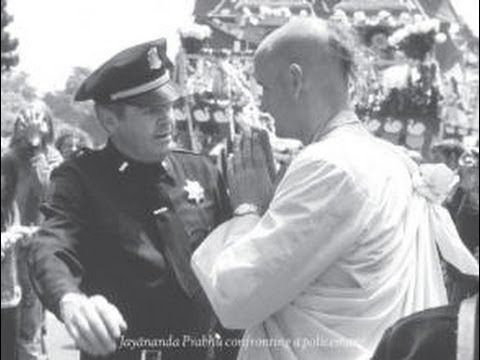 TO LOVE AND BE LOVED: There are primarily two underlying forces in the universe indiscernible by ordinary sensual or modern scientific observation, namely the forces of karma (selfish exploitation of matter), and the force of bhakti (selfless loving service to God). That which is greater than us can’t be understood by force, but only by loving service. When you love someone or the Source of everything, they will be open to reveal all their secrets. There are many, many ways people have spoken about these two forces—or levels of understanding and their implications—according to their belief systems and goal of their lives.
TO LOVE AND BE LOVED: There are primarily two underlying forces in the universe indiscernible by ordinary sensual or modern scientific observation, namely the forces of karma (selfish exploitation of matter), and the force of bhakti (selfless loving service to God). That which is greater than us can’t be understood by force, but only by loving service. When you love someone or the Source of everything, they will be open to reveal all their secrets. There are many, many ways people have spoken about these two forces—or levels of understanding and their implications—according to their belief systems and goal of their lives.
One way of speaking about karma and bhakti is what the personified Vedas state in the 10th Canto of Shrimad Bhagavatam that there are two purposes of the material world: facilities for the living entity to enjoy their senses and mind in unlimited varieties, facilitated by new opportunities thru re-births and deaths to try again, and the higher facility for liberation through realizing one’s spiritual nature and the source of real happiness within. Ultimately, in its highest reach, my understanding is that this culminates in bhakti or loving devotion to various forms of God, for Gaudiya Vaishnavas, Radha and Krishna, or Shri Chaitanya and Nitai, etc. We are sparks of divinity meant to live in relationship to it and under its shelter.
In the lower stages of bhakti we are continually confronted, at times assaulted or harassed it can seem, with the choice to follow the ways of the world through material enjoyment or to engage in acts favorable for spiritual advancement in bhakti. We can call these two endeavors, the path of darkness and bondage, or the path of light and liberation.
Vyasapuja
→ Ramai Swami
The devotees assembled at our beautiful Radha Rasesvara temple in Bali to celebrate Srila Bhakti Svarupa Damodara Goswami’s Vyasapuja.
His holiness left our association for the eternal abode in 2006 but visited Indonesia many times and made hundreds of disciples there.
The day started with abhiseka, then homages, dance, lilas performed by our junior and senior school children, puspanjali and finally prasadam.
I was invited as a guest to give my remembrances of Maharaja.
Ecstatic and blissful surrender
→ KKSBlog
(Kadamba Kanana Swami, 04 January 2008, Stockholm, Sweden)
 We cannot just declare, “I have surrendered!” No, one has to surrender again and again; it is an ongoing process. One has to gain the favour of Krsna eternally. This is quite something!
We cannot just declare, “I have surrendered!” No, one has to surrender again and again; it is an ongoing process. One has to gain the favour of Krsna eternally. This is quite something!
We need to take spiritual life to stage of no compromise, meaning that for Krsna nothing but the best will do – no half work, no half standards. No, everything complete, all the way and then of course Krsna will also come all the way.
If we only go halfway, he will also come that far and then God is far away. But if we go close, he will come very close also, until a very deep intimate relationship develops between the Lord and the devotee. This is possible and this is real spiritual life and then you become a Vaikuntha man. But if we do just half the work then Krsna is sort of a fairy tale – some bluish, blackish personality with the flute, living in the celestial forest with amazing friends and pastimes BUT what has this got to do with real life.
However one who deeply surrenders his life to Krsna, he begins to perceive the spiritual dimension more and more. He begins to perceive Krsna and then life becomes fun, instead of a struggle. He becomes quite ecstatic and blissful and this, of course, is what spiritual life is meant to be.
New Multi-Speciality Hospital to Open at Sri Mayapur
→ ISKCON News

The city of Sri Mayapur is expanding with its number of residents and visitors increasing every passing year. Owing to this, a brand new multispecialty hospital project has been initiated to provide health care at Sri Mayapur. On November 12th, a ground breaking ceremony for the hospital took place which was graced by Jayapataka Swami, Hridaya Chaitanya Das, Bhakti Purushottam Swami, Bhakti Nityananda Swami and other senior Vaishnavas.
Eco-Village Sustainable Communities
→ ISKCON News

Now more than ever before people all over the planet are seeking new sustainable models for living. EcoVillages and ecological communities have been emerging as a viable alternative where people can live together in cooperation and harmony with the natural world. 'A New We' explores 10 such communities in Europe (including Krishna-valley in Hungary) and opens doors to further exploration and discovery on the new 'Global EcoVillage & Sustainable Community Network'.
Bhaktivedanta Manor Bans Tallow Note, Sparks Debate
→ ISKCON News

Bhaktivedanta Manor, the largest ISKCON temple in the UK, has stopped accepting a new five pound note that contains traces of tallow, made with animal fat like mutton and beef. Many devotees support the move. Many others, however – while agreeing with the principle that there should not be meat fat in currency we all have to use – have issues with the practicality and even the philosophical grounding in actually banning it.
ISKCON’s 50th and ISKCON-London’s 47th Anniversary Celebrated at a Signature Event
→ ISKCON News

ISKCON-London celebrated the 47th Anniversary of the installation of Sri Sri Radha-Londonisvara on Sunday, 29th November. This special 50th Anniversary year of ISKCON, themed “The Joy of Devotion”, has been filled with many joyous celebrations both in London and worldwide. This particular event was one of the signature events this year, and was held at a big theatre-style venue in central London.
Winter Arrives at New Vraja Dhama
→ ISKCON News
The Super Soul Does It Again!
Recently I was distributing books…
→ Dandavats

The Super Soul Does It Again!
Recently I was distributing books door to door in Gisborne, New Zealand.
I knocked on one door and had the great fortune to meet Caleb (see attached photo), a very pleasant middle aged gentleman and committed Christian. As a successful musician, one of the ways he serves is to glorify God though music at Christian gatherings all around the world. Still, I could understand from his respectful and friendly demeanor that he was open to receiving one of Srila Prabhupada’s books.
Utilizing the clever presentation HG Vijay Prabhu kindly shared with us (that Prabhupada’s books provide strong arguments with which to defeat atheism and are therefore relevant to all theists) I confidently showed him Srimad Bhagavatam 1.1. Fortunately, Caleb deeply appreciated the truth and beauty of SB and was very eager to take a copy. When I asked him for a donation, a wry smile came to his face.
Popping back into his house, he returned a moment later with a nice donation. Then he explained: “Normally I never keep cash. However, when I was driving back home earlier today, I felt compelled to stop at an ATM to withdraw this money. At the time I did not know what the money would be used for, but I could understand that God was directing me and that the reason would become apparent in due course. So when you asked for a donation everything made sense.” As Krishna explains in Bhagavad Gita, 18.14, the Supersoul is the ultimate factor of action. By participating in Lord Caitanya’s Sankirtan movement we can perceive this and increase our faith in Krishna.
Srila Prabhupada ki jaya!
Your aspiring servant,
Caitanya Vihara das
Tuesday, December 6th, 2016
→ The Walking Monk
Rescued Bull Calves Safe at ISCOWP (7 min video)
These two bull…
→ Dandavats

Rescued Bull Calves Safe at ISCOWP (7 min video)
These two bull calves were rescued from a dairy a week ago. They will be prote...
Concentration on brahmacarya? Is it for you?
→ Dandavats
 By Vivasvan das
By Vivasvan das “One whose activities are strictly spiritually dedicated to the supreme Lord has thus become a brahmacari.” Or “To act on the spiritual platform.” Brahamcarya means the development of a positive, active spiritual life with an avowed determination to avoid the unnecessary entanglements in material life, (that the intimate association of the opposite sex forces one to be involved in) through spiritual cultivation of Krishna conscious devotional principles in the association of Sri Guru and the Vaisnavas. Without this development, brahmacarya, although purifying, remains an external designation only. Continue reading "Concentration on brahmacarya? Is it for you?
→ Dandavats"
Daily Darshan:December8,2016
→ Mayapur.com
The post Daily Darshan:December8,2016 appeared first on Mayapur.com.
ISKCON Mira-road attracts 5,000 students
→ Dandavats
 By Krishna Nandan Das & Bhagavati Kripa Devi Dasi
By Krishna Nandan Das & Bhagavati Kripa Devi Dasi On the most auspicious occasion of ISKCON celebrating 50 years and ISKCON Mira-road celebrating first year after inauguration, which took place in September 2015, HG Kamalalochana Prabhu – President of ISKCON Mira-road, instructed his team of devotees to invite 10,000 school children for Brahmotsava. To fulfill this instruction Bhaktin Samhita came up with a very beautiful brochure to attract the Principals of different schools, so that they would agree to bring their students for field trip to ISKCON. Continue reading "ISKCON Mira-road attracts 5,000 students
→ Dandavats"
Passing of HG Narayan Prabhu ACBSP
→ Dandavats

Passing of HG Narayan Prabhu.
Dear Godbrothers and Godsisters,
Please accept my humble obeisances. All glories to Srila Pr...
The effects of Viber, Whatsapp, SMS, Skype, etc
→ SivaramaSwami.com
Converstation.
Satisfaction is one of the austerities of the mind.In…
→ Dandavats

Satisfaction is one of the austerities of the mind.
In Bhagavad-gita 17.16, Krsna says that satisfaction is one of the austerities of the mind.
There are plenty of circumstances while traveling to analyze the fluctuations of the mind. A friend of mine once said, “When you’re home, you get what you want. When traveling, you get what you get.”
Moving from place to place requires adjusting to new environments and situations and gives ample opportunity to practice satisfaction of the mind.
Noteworthy is that satisfaction is not dependent on our external environment. Rather, it comes as a result of practice.
The word satisfy comes from the Latin words, “satis,” which means, “enough” + “facere,” which means, “make.” Satisfaction: “make enough.”
Centuries ago, Lao Tzu, the famous Chinese philosopher said: “He who knows that enough is enough will always have enough.”
Watching a little baby during one of our flights, I witnessed how her moods changed frequently, her peaceful smiling quickly changing to red-faced crying and then back to smiling a while later.
Seeing her, I imagined her to be a personification of my own mind, always oscillating, accepting one thing and a minute later rejecting the same thing.
In Bhagavad-gita 2.55 Krsna calls this tendency of the of the mind, manah-gatah, “mental concoction.” Or more literally, manah-gatah means, “the mind goes.”
Observe your mind for a while, watching where it goes and how it changes.
To “identify with something” means to take it on. But since you are not the mind, you are not obligated to identify yourself with the thoughts and moods that constantly float though it.
When thoughts of dissatisfaction float by observe them and let them go by like passing clouds.
Instead, attach yourself to Krsna’s words in Bhagavad-gita like these: “My devotee who is not dependent on the ordinary course of activities, who is pure, expert, without cares, free from all pains, and not striving for some result, is very dear to Me.” (Bg 12.16) “He who is satisfied with gain which comes of its own accord, who is free from duality and does not envy, who is steady in both success and failure, is never entangled, although performing actions. (Bg 4.22)
Hare Krishna!
Vaisesika das
A Venus flytrap and how to resist it.
A Venus flytrap can digest…
→ Dandavats

A Venus flytrap and how to resist it.
A Venus flytrap can digest an insect in about 10 days . The unsuspecting bug smells nectar on the leaves that form the trap. When the insect investigates, it crawls into the jaws of the plant. Within half a second the jaws clamp shut and digestive juices dissolve the bug.
This meat-eating plant reminds me of the way our material mind can devour us if we are lured into thoughts of enjoying this material world for selfish purposes, tempting us with a new experience, convincing us that living right doesn’t matter, or appealing to our physical senses.
It is certainly worthwhile knowing how to control the Venus fly trap of a mind.
Lord Krishna says in the Bhagavad-gita that the mind can be controlled by constant “practice and detachment.” (Bhagavad-gita, 6.35).
“He says that wherever and whenever the mind wanders, due to its flickering and unsteady nature, we must bring it back under the control of the Self” (Bhagavad-gita, 6.26)
Ultimately, we must develop a higher taste.
Lord Krishna says, “The embodied soul may be restricted from sense enjoyment, though the taste for sense objects remains. But, ceasing such engagements by experiencing a higher taste, he is fixed in consciousness.” ( Bhagavad-gita 2:59).
That higher taste is engaging in devotional service, the easiest of which is chanting the Lord’s holy Names:
Hare Krishna Hare Krishna Krishna Krishna Hare Hare Hare Rama Hare Rama Rama Rama Hare Hare.
Dear Lord Krishna, at times I let down my guard and my mind takes over. Please help me to listen to Your warnings and follow Your instructions.
Bhakta Dasa …Communications minister ISKCON Australia
Cleaning and Renovations of the iskcon Honolulu temple. (Album…
→ Dandavats

Cleaning and Renovations of the iskcon Honolulu temple. (Album with photos)
Srila Prabhupada would stay there for many days do...
ISKCON’s 50th Anniversary and ISKCON-London’s 47th Anniversary celebrated at a signature event in London
→ Dandavats
 By ISKCON-London Communications
By ISKCON-London Communications ISKCON-London celebrated the 47th Anniversary of the installation of Sri Sri Radha-Londonisvara on Sunday, 29th November. This special 50th Anniversary year of ISKCON, themed “The Joy of Devotion”, has been filled with many joyous celebrations both in London and worldwide. This particular event was one of the signature events this year. Held at a big theatre-style venue in central London, the cultural programme started with a sumptuous prasadam feast followed by a line-up of dance, drama, and speeches, ending with a lively kirtan that got everyone off their seats and dancing! Continue reading "ISKCON’s 50th Anniversary and ISKCON-London’s 47th Anniversary celebrated at a signature event in London
→ Dandavats"
Who is a bonafide Guru?
Srila Prabhupada: The qualification of a…
→ Dandavats

Who is a bonafide Guru?
Srila Prabhupada: The qualification of a spiritual master is that he must have realized the conclusions of the scriptures by deliberation and arguments and thus be able to convince others of these conclusions. Such great personalities who have taken shelter of the Supreme Godhead, leaving aside all material considerations, are to be understood as bona fide spiritual masters. — NOD Ch. 7
To read the entire article click here: https://goo.gl/jqXYh1
Srimad Bhagavatam – The Perfect Gift
→ The Toronto Hare Krishna Temple!
This holiday season, take the perfect gift for your family & friends - a set of Srimad Bhagavatam (Bhagavat Purana), also called ‘the ripened fruit of all Vedic literature’. The complete Srimad Bhagavatam set contains 12 cantos in a beautiful 18 volume hardbound set, and is available also in Hindi, Tamil, Bengali, Gujarati, Telugu, and many other languages. Click here to get a glimpse into the Srimad Bhagavatam!
In order to share this gift widely, it is being offered at a discounted price of $299, or only $29/month on a payment plan (offer ends Dec 31st). Please reserve your copy now before we are sold out! If you already have the Srimad Bhagavatam, we are making the entire nine volume Caitanya Caritamrita available for just $99!
Please help us preserve these priceless gems of Vedic wisdom for the generations to come!
We’re Looking for Website Contributors
→ The Toronto Hare Krishna Temple!
Maybe you have some neat recipes to share, or want to share Krsna conscious videos, or even have some wonderfully crazy idea that we just haven't thought of. Now's your chance to contribute!
If you have some neat idea to bring to the table, or if you just want to join the team, please feel free to fill out the form below! Hare Krsna!
ISKCON 50 Meditations: December 8, 2016
→ ISKCON News
Bull Calves Rescued by ISKCOWP
→ ISKCON News

These two bull calves were rescued from a dairy recently by the activists of ISKCOWP (International Society of Cow Protection.) These calves will be protected for life and trained as an ox team to show their usefulness as an argument against their slaughter. In the dairy they are considered useless because they do not produce milk. Unless rescued they will be sold as meat. More information about the project: http://iscowp.org. A video by Chayadevi Dasi.
Be brave in Krsna consciousness
→ KKSBlog
(Kadamba Kanana Swami, 06 May 2002, Srimad Bhagavatam 1.5.11)
 Resistance to surrender comes from maintaining material attachments even after receiving so many instructions on this subject matter. This is what holds us back! But how do we overcome this obstacle? We do so by being brave in Krsna consciousness, by being brave to choose for Krsna. We cannot just be ordinary devotees and just let our spiritual life go along. No, we have to be brave to do something special for Krsna. This is what is required! Let us try to be the exception. Let us not be of average standard and say, “Well, everybody is doing it like this so you cannot expect anything more from me.”
Resistance to surrender comes from maintaining material attachments even after receiving so many instructions on this subject matter. This is what holds us back! But how do we overcome this obstacle? We do so by being brave in Krsna consciousness, by being brave to choose for Krsna. We cannot just be ordinary devotees and just let our spiritual life go along. No, we have to be brave to do something special for Krsna. This is what is required! Let us try to be the exception. Let us not be of average standard and say, “Well, everybody is doing it like this so you cannot expect anything more from me.”
No, let us do something brave for Krsna and Prabhupada and then we will conquer our obstacles. We see in the scriptures the descriptions of those who conquered, they all made special endeavour. So let us try doing something extraordinary in our own way, according to our own inspiration. It is between us and Krsna.
We see in the Bhagavatam, in these pastimes, these personalities all did something special and they got special mercy and it is by mercy that we are going to be purified. We cannot purify ourselves, it is by mercy. We must attract mercy; we need mercy of the devotees, of the sadhus, of real saintly people and we the need mercy of Krsna.
Saintly people are merciful but they do not get too involved with people who are too materially entangled, they give a bit of mercy but then they withdraw from that association. So the more one is endeavouring to be Krsna conscious, the saintly people will notice that and will want to give their mercy. We all can equally attract the mercy of Krsna by special endeavour. This is the only way, there is no other way, be brave and trust Krsna.
Monday, December 5th, 2016
→ The Walking Monk
Sunday, December 4th, 2016
→ The Walking Monk
Saturday, December 3rd, 2016
→ The Walking Monk
Science of Ayurveda and its growth in the west
→ Dandavats
 One of the annual events at the Bhaktivedanta Manor, in the UK, is the Ayurvedic retreat, conducted by Dr Vasant Lad. Hailing from Maharashtra in India, Dr Lad is one of the foremost authorities in Ayurveda and comes from a long line of practitioners. Ayurveda is the Vedic science of healing that incorporates medicine, diet and herbology. Ayurvedic practices even featured in the Ancient epic Ramayana, specifically when Sushena ordered Hanuman to retrieve the Sanjivani herb to revive Laxman from his injury.
One of the annual events at the Bhaktivedanta Manor, in the UK, is the Ayurvedic retreat, conducted by Dr Vasant Lad. Hailing from Maharashtra in India, Dr Lad is one of the foremost authorities in Ayurveda and comes from a long line of practitioners. Ayurveda is the Vedic science of healing that incorporates medicine, diet and herbology. Ayurvedic practices even featured in the Ancient epic Ramayana, specifically when Sushena ordered Hanuman to retrieve the Sanjivani herb to revive Laxman from his injury. 
